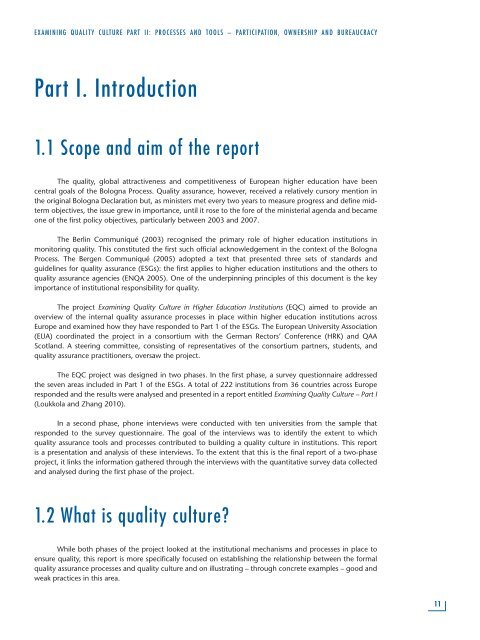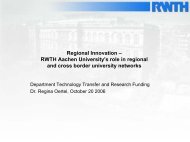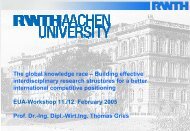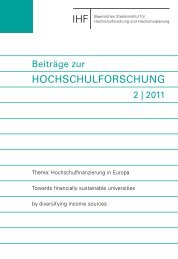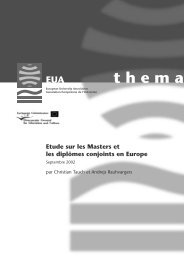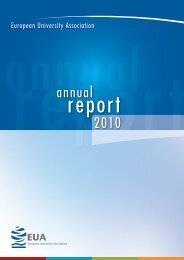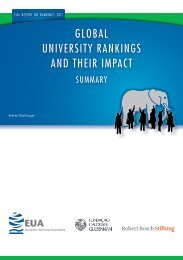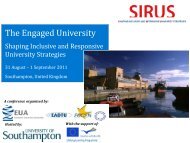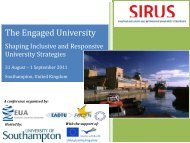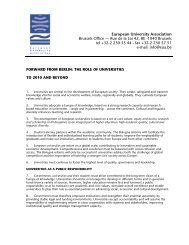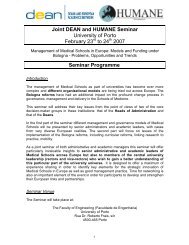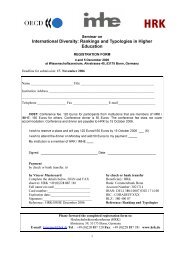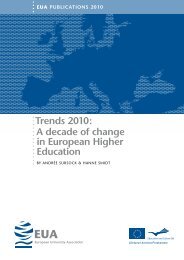Examining Quality Culture Part II: - European University Association
Examining Quality Culture Part II: - European University Association
Examining Quality Culture Part II: - European University Association
Create successful ePaper yourself
Turn your PDF publications into a flip-book with our unique Google optimized e-Paper software.
ExAmININg QUALITy CULTUrE PArT <strong>II</strong>: PrOCESSES ANd TOOLS – PArTICIPATION, OwNErShIP ANd BUrEAUCrACy<br />
<strong>Part</strong> I. Introduction<br />
1.1 Scope and aim of the report<br />
The quality, global attractiveness and competitiveness of <strong>European</strong> higher education have been<br />
central goals of the Bologna Process. <strong>Quality</strong> assurance, however, received a relatively cursory mention in<br />
the original Bologna Declaration but, as ministers met every two years to measure progress and define midterm<br />
objectives, the issue grew in importance, until it rose to the fore of the ministerial agenda and became<br />
one of the first policy objectives, particularly between 2003 and 2007.<br />
The Berlin Communiqué (2003) recognised the primary role of higher education institutions in<br />
monitoring quality. This constituted the first such official acknowledgement in the context of the Bologna<br />
Process. The Bergen Communiqué (2005) adopted a text that presented three sets of standards and<br />
guidelines for quality assurance (ESGs): the first applies to higher education institutions and the others to<br />
quality assurance agencies (ENQA 2005). One of the underpinning principles of this document is the key<br />
importance of institutional responsibility for quality.<br />
The project <strong>Examining</strong> <strong>Quality</strong> <strong>Culture</strong> in Higher Education Institutions (EQC) aimed to provide an<br />
overview of the internal quality assurance processes in place within higher education institutions across<br />
Europe and examined how they have responded to <strong>Part</strong> 1 of the ESGs. The <strong>European</strong> <strong>University</strong> <strong>Association</strong><br />
(EUA) coordinated the project in a consortium with the German Rectors’ Conference (HRK) and QAA<br />
Scotland. A steering committee, consisting of representatives of the consortium partners, students, and<br />
quality assurance practitioners, oversaw the project.<br />
The EQC project was designed in two phases. In the first phase, a survey questionnaire addressed<br />
the seven areas included in <strong>Part</strong> 1 of the ESGs. A total of 222 institutions from 36 countries across Europe<br />
responded and the results were analysed and presented in a report entitled <strong>Examining</strong> <strong>Quality</strong> <strong>Culture</strong> – <strong>Part</strong> I<br />
(Loukkola and Zhang 2010).<br />
In a second phase, phone interviews were conducted with ten universities from the sample that<br />
responded to the survey questionnaire. The goal of the interviews was to identify the extent to which<br />
quality assurance tools and processes contributed to building a quality culture in institutions. This report<br />
is a presentation and analysis of these interviews. To the extent that this is the final report of a two-phase<br />
project, it links the information gathered through the interviews with the quantitative survey data collected<br />
and analysed during the first phase of the project.<br />
1.2 what is quality culture?<br />
While both phases of the project looked at the institutional mechanisms and processes in place to<br />
ensure quality, this report is more specifically focused on establishing the relationship between the formal<br />
quality assurance processes and quality culture and on illustrating – through concrete examples – good and<br />
weak practices in this area.<br />
11


